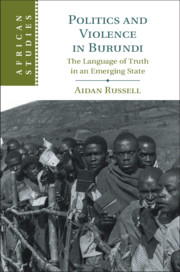Book contents
- Politics and Violence in Burundi
- African Studies Series
- Politics and Violence in Burundi
- Copyright page
- Contents
- Figures and Maps
- Acknowledgements
- Linguistic and Orthographic Note
- Glossary of Terms
- List of Abbreviations
- Introduction
- Prologue, 1796–1959
- Part I 1959–1961: ‘To See the Son of a King’
- Part II 1961–1967: ‘A Most Total Anarchy’
- Part III 1968–1972: ‘Please Send Me a Car to Take Them Away’
- 5 Politiques bw’insaku
- 6 Couper tout ce qui dépasse
- Conclusion
- Bibliography
- Index
- African Studies Series
6 - Couper tout ce qui dépasse
Truth and Violence
from Part III - 1968–1972: ‘Please Send Me a Car to Take Them Away’
Published online by Cambridge University Press: 03 October 2019
- Politics and Violence in Burundi
- African Studies Series
- Politics and Violence in Burundi
- Copyright page
- Contents
- Figures and Maps
- Acknowledgements
- Linguistic and Orthographic Note
- Glossary of Terms
- List of Abbreviations
- Introduction
- Prologue, 1796–1959
- Part I 1959–1961: ‘To See the Son of a King’
- Part II 1961–1967: ‘A Most Total Anarchy’
- Part III 1968–1972: ‘Please Send Me a Car to Take Them Away’
- 5 Politiques bw’insaku
- 6 Couper tout ce qui dépasse
- Conclusion
- Bibliography
- Index
- African Studies Series
Summary
In 1972, a localised rebellion against the Tutsi-dominated state triggered a ‘selective’ genocide against the Hutu population. This chapter considers the actions and representations of the rebellion, then examines the phases of genocidal repression: massacres in the areas affected by the rebellion, the elimination of prominent politicians, and the decentralised arrest and disappearance of key individuals across the countryside. It explores the processes of legal triage that authorised the murder of civilians through the categorisation of suspicious classes of local intellectuals, teachers, priests and successful traders. It devotes special attention to the role of the youth league in the local repression, partly captured by the control of information and the bureaucratisation of violence. It then considers the different faces of truth in violence: total state denial, the use of frank truth as hopeless protest, the lingering possibilities of loyalty to official truth, and the construction of new truths in the aftermath. The chapter ends with the popular renditions of a postcolonial order, in the nature of violent authority and ethnic community, as being revealed through violence.
- Type
- Chapter
- Information
- Politics and Violence in BurundiThe Language of Truth in an Emerging State, pp. 227 - 269Publisher: Cambridge University PressPrint publication year: 2019

